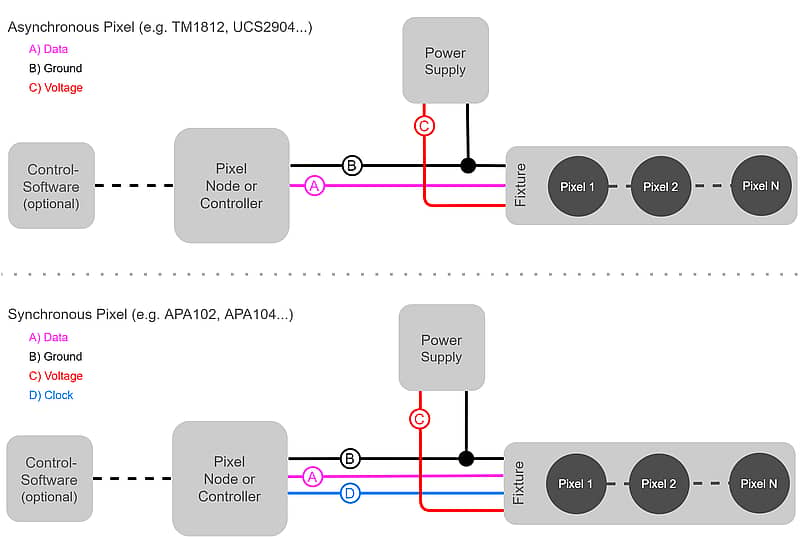- Products
-
- Projects
-
- Solutions
- Resources
- About
-
-
-
- About Us
- Our Story
- Sustainability
- News
- Our Brands
- Traxon Dynamic Lighting
- e:cue Lighting Controls
- OSRAM General Lighting*
- Our Technology
- Dynamood
- Pixel Protocol
-
-
-
Get2know: asynchronous & synchronous (SPI) protocols
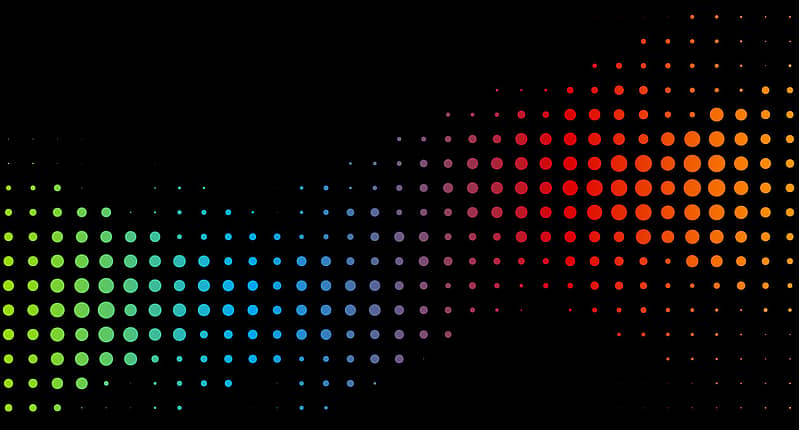
DMX is very common for the control of dynamic luminaires and offers many advantages, but the differential protocol (D+,D-) must be converted e.g. into an asynchronous protocol for the control (dimming) of luminaires and pixels. This requires additional components and space inside the luminaire. Also, the number of channels is limited to 512. Especially for products like single-pixel controllable flex-tapes or chains this can be a disadvantage. Here it often makes sense to send directly the asynchronous or synchronous protocols directly to the converter/dimmer (chip). There are many chip types (RGB, RGBW, Monochrome) and chip manufacturers as well as those directly integrated in the LED or separately on the PCB.
This saves a lot of space, reduces hardware costs and allows a high number of channels to be controlled per line – resulting in new creative, higher resolution and highly flexible products. Due to the fact that the protocol is not differential (data+, data-) like DMX, the distance between the output device and the luminaire is reduced to about 3 m. With special converters – e.g. the e:cue Pixel Range Extender – the corresponding asynchronous protocol can be reliably transported up to 300 m. Here the controller first outputs the asynchronous protocol “differentially” (data+, data-, ground) and then converts it back again just before the LED product (D, ground).
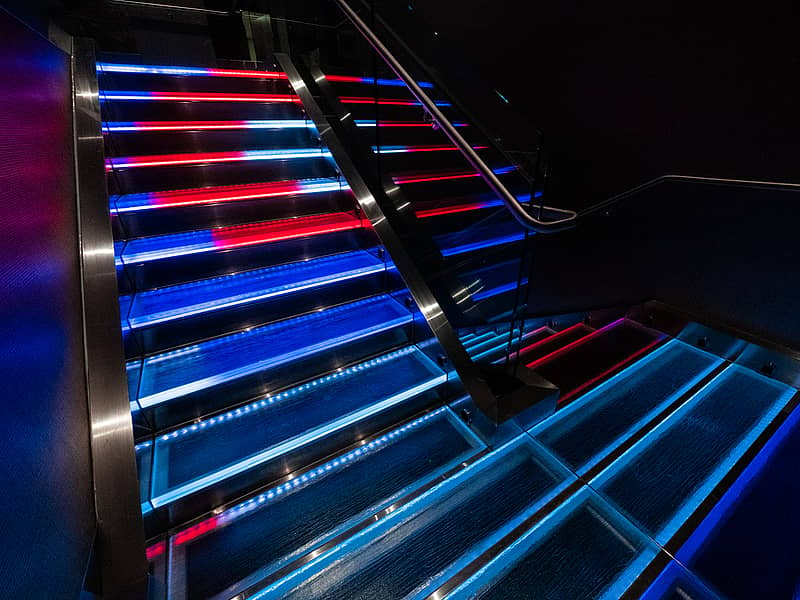
(bar, clubs) LED pixel strips, contour fixtures
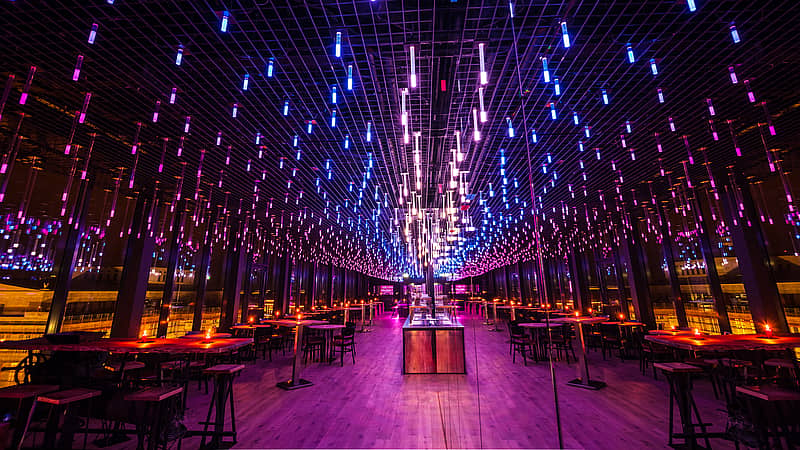
Pixel tubes, pixel mesh, dots, LED tapes
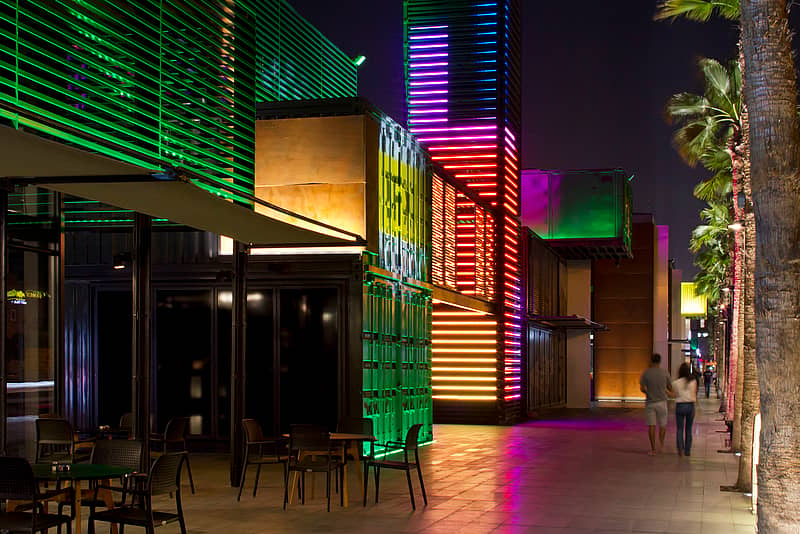
Contour fixtures, mesh, boards, LED tapes

Mini LED chains, coloured LED strips
| DMX/e:pix | Asynchronous | Synchronous (SPI) | |
|---|---|---|---|
| Chip examples | TM1812, UCS2904, WS2813 ... | APA102 | |
| Max channels | 512 (e:pix 2048) | Around 2000 | Around 2000 |
| Typical wiring | Data+, Data-, Ground | Data, Ground | Data, Ground, Clock |
| Feedback (RDM) | Optional | No | No |
| Max distance between controller and first pixel | 150 m | Approx. 3 m, with Pixel Range Extender up to 300 m | Approx. 3 m |
| Typical application / products | Illumination with washer & liners, dot chains & low resolution tubes, strips & boards | Medial and artistic installations. Pixel tapes, tubes, LED chains, pixel mesh, boards. Products with high pixel density (resolution) | Medial and artistic installations. Pixel tapes, tubes, LED chains, pixel mesh, boards. Products with high pixel density (resolution) |
The data signal is transmitted with approx. 5 V. The controller should be placed as close as possible to the luminaire (max. 3 m). If this is not possible, a range extender is recommended, which allows up to 300 m distance with asynchronous protocols. The LEDs also receive a supply voltage – usually between 5 and 48 V. Consider the power consumption of your pixel products. In addition, depending on the cabling length, increased power supply might be necessary.
Actually there is no fixed rule like e.g. with DMX – but there are differences between the chips. The data distribution runs over shift registers to guarantee the same strong signal for all chips – however, the more pixels are connected in a row, the higher the data rate becomes. If the data stream becomes too large (fast), it can lead to data shifts – the pixels start to flicker. We give 2048 pixels as a guideline – but more (or less) are also possible. This should be evident from the data sheet of the respective chip manufacturer.
For long lengths, shielded cables such as DMX cables or Cat 5e are recommended. In general, you can split the supply line and distribute it to several pixel products. However, the same signal is then present everywhere – splitting with address shifts is not possible.
Here it depends on the pixel chip used. It is possible that the signal, which is passed on from pixel to pixel (daisy chain), can no longer be passed on if a chip/pixel fails. However, there are chips that have a protection or a “data bypass” built in. This ensures that the subsequent pixel continues to be supplied with data stream.
This should be evident from the manufacturer’s data sheet or manual. Alternatively, the dealer of the product will be able to provide information here.
Often protocols can be easily added via firmware update. In addition, e:cue offers you an expert mode where you can enter protocol-specific parameters and thus create your own “library entry”.
DMX is recommended for larger distances between several luminaires (e.g. for facade lighting) or for low-resolution pixel applications. Also if you need information from the luminaire (RDM), you should choose DMX. A-/ synchronous protocols show their strength especially when many single light points are close to each other (high resolution).
That depends on what the manufacturer of the product or the chip specifies here. The controller reliably transfers the data signal to the first pixel, and from there the signal is partially processed and passed on from pixel to pixel.
Yes, a-/synchronous LEDs or chips are very simple. Because you hardly need any peripherals, you can build your own lights with the power supply and the pixel signal. It also requires very little space, allowing you to implement great projects.
Quite simple – just like with a SYMPL dmx Node or SYMPL e:pix node. Create content and assign the corresponding universes to the outputs of the respective pixel controller. In addition, you only have to configure at the controller which pixel protocol should be used for the output.
